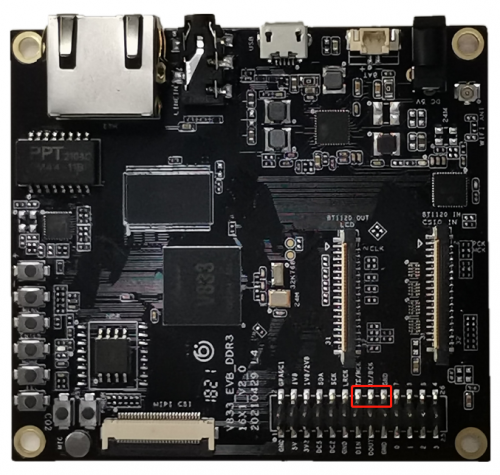Lindenis V833
Contents
Key Features
Processor core
- Single-core ARM Cortex-A7 Processor
- ARMv7 ISA standard ARM instruction set
- Thumb-2 Technology
- Jazeller RCT
- NEON Advanced SIMD
- VFPv4 floating point
- 32KB L1 Instruction cache and 32KB L1 Data cache
- 128KB L2 cache
Video Encoding Performance
- H.264 BP/MP/HP, H.265 Main Profile encoding
- I/P/Dual P frame H.264/H.265 encoding
- MJPEG/JPEG baseline encoding
- Real-time multi-stream H.264/H.265 encoding capability:
- 5M@20fps + 1080p@20fps (or 1080p@60fps + VGA@60fps ) H.264
- 5M@30fps + 720p@30fps (or 1080p@90fps) H.265
- Maximum 8-megapixel resolution for H.264/H.265 encoding
- JPEG snapshot performance of 1080p@60fps independently
- CBR, VBR modes
- Output bit-rate ranging from 2kbit/s to 100Mbit/s.
- Maximum 16 ROIs without encoding for AI
- Encoding frame rate ranging from 1/16 fps to 60fps.
Video and Graphics Processing
- Support Electronic Image Stabilization Engine
- Supports Lens distortion correction, fisheye PTZ and calibration
- Picture rotation by 90°180°270°
- Support 2 Video channels, one up to 1080p@60fps, the other one up to 720p@60fps
- Support 1 UI channel, up to 1080p@60fps
- Blending of 2 Video channels and 1 UI channel
- Support SmartColor for excellent display experience
NPU Processing
- Maximum performance up to 0.4Tops
- Support Conv, Activation, Pooling, BN, LRN, FC/Inner Product
- Support Face detect, face recognition, human detection
Professional Image Effects
- Maximum performance is 2592 x1936@30fps
- Maximum resolution of is 2688 x 2688
- Adjustable 3A functions (AE, AWB and AF)
- Supports 2F WDR and Local Tone mapping,
- Supporting highlight suppression and backlight compensation, bad pixel correction, Lens shading correction
- Supports defect pixel correction, 2D/3D denoising.
- Supports image mirroring and flipping
- Provides ISP tuning tools for the PC
Various interfaces
- Wi-Fi : XR819
- BT1120 IN/OUT
- SPK, LINE-IN
- MIPI CSI, MIPI DSI, TP
- KEY, POWER_KEY, FEL
- Network: 10/100Mbps Ethernet
- USB: 1 x Micro USB, TF card
- Power Supply: 5V/2A micro USB, 5V/2A DC-IN, 3.7V Battery
Software Support
- Tina (base on linux-4.9)
- RTOS
Target Applications
- SDV
- Smart IPC
- Smart Camera
Accessories Step-by-Step Guides
Power Supply
LCD
Hardware Specification
Board Features
Video Out
- MIPI-DSI, 4 lanes, up to 1080P
- LCD interface
- BT1120 OUT
Video In
- 1 x MIPI-CSI - Camera interface, 4 lanes per channel
- BT1120 IN
Audio
- 3.5mm Line in
- SPK
- 1 x mic
Network
- 10/100/100 Ethernet
- WiFi 2.4G
Storage
- MicroSD Card bootable, support SDHC and SDXC, storage up to 256GB
Expansion Ports
- Flexible Pin Headers 2x13 pins Reserved:
- GPADC
- 5V, 1V8, 2V8 and DC Power Supply
- I2C x 1
- I2S x 1
- PWM x 1
Board Information
- Board Dimensions: 75mm x 68mm
- Input Power: 5V@2A micro USB connector, 3.7V Li-Ion battery connector
Datasheet
SDK
Overview
Features
- Linux kernel 4.9 (official version)
- U-Boot 2014.07
- ARM GCC based cross toolchain
- Integrated build system
Layout
├── build ├── config ├── Config.in ├── dl ├── lichee ├── logs ├── Makefile ├── package ├── prebuilt ├── rules.mk ├── scripts ├── softwinner ├── target ├── toolchain └── tools
Download and Build
Prebuilt Image
System requirements
Listed below are the recommended requirements for downloading and building the SDK:
- CPU: x86_64 or better family processor
- Memory: 8GB or higher
- Disk: 20GB free hard disk space, if you build it in a Virtual machine, I recommand you allocate a 30G virtual hard disk.
- The Whole SDK is about 15G.
- OS: Ubuntu 14.04 (tested) or higher
- Network: internet connection
Lazy Start
Linux host setup
Ubuntu 14.04
HINT: later version should also work.
Install prerequisites
$ sudo apt-get update $ sudo apt-get install build-essential libncurses5-dev zlib1g-dev gawk git git-core ccache gettext libssl-dev xsltproc gperf subversion $ sudo dpkg --add-architecture i386 $ sudo apt-get update $ sudo apt-get install lib32z1 lib32ncurses5 libc6:i386 libstdc++6:i386
Sudo without password
$ sudo visudo
Add this line at the end (change “tom” to your username):
tom ALL=(ALL) NOPASSWD: ALL
Ctrl-X to leave, save your changes, and you're done!
Downloading
Building
Setup env
Build source
Build image
Installation
OS
Overview
Framewrok
Libraries
Linux Kernel
Reference Documents
System Setup
Uart
- By default, the ttyS3 is assigned to the Linux console. The UART transmit pin called "TX" and receive pin called "RX" are in the J12 pin group, whose label is DEBUG. And the bit rate is 115200 bps.See below red rectangle.
